Here are 5 Reasons Why Your Car Won’t Start!
Posted on March 12, 2024 by Nur Wachda Mihmidati

A car that won’t start is one of the most annoying problems a driver can face. When the key is turned in the hope that the engine will start, but only hear a hollow sound or no reaction at all, it can be a moment of frustration that disrupts our daily plans.
In this article TransTRACK, we will explore the reasons behind this problem and provide practical solutions to solve a car that won’t start. From checking the battery to checking other important components such as spark plugs and fuel pump, let’s find out what can be done when the car won’t start.
Causes of a car not starting
There are several common reasons why a car won’t start. Here are some of them:
Spark Plug Disruption
Spark plugs are an important component in the engine combustion system. Damaged or dirty spark plugs can disrupt the process of burning fuel in the combustion chamber. When the spark plug is not functioning properly, the air and fuel mixture may not burn completely or even at all, causing the engine to not start. A faulty spark plug is usually characterized by burnt or overly corroded electrodes, and in some cases, scale or dirt attached to them.
Damage to the Starter Dynamo
The starter dynamo is responsible for mechanically turning the engine so that it can be started. If the starter armature is damaged, such as a worn starter gear or a damaged starter motor, the engine will not start properly. Signs of a faulty starter armature include the sound of the starter turning without producing engine revs or a rattling sound when trying to start the engine.
Faulty Water Temperature Sensor (WTS)
The water temperature sensor (WTS) provides information about the engine coolant temperature to the engine control unit (ECU). This data is important for combustion settings and engine performance adjustments. If the water temperature sensor is faulty or gives incorrect readings, the ECU may not give the signal to start the engine or adjust the combustion properly, which can cause problems in starting the car.
Overheated Coil
The coil is the part of the ignition system that is responsible for converting the low voltage from the battery into the high voltage needed to ignite the spark plug. If the coil overheats, it can experience overheating or short circuit, which will impair its performance. As a result, the ignition system will not function properly and the engine will not be able to start.
Other possible causes to consider include a weak or dead battery, damaged or loose ignition wires, a faulty starter relay, or problems with the fuel system such as a faulty fuel pump or clogged injectors. It is important to perform a thorough diagnosis and fix the problem with the help of a trained technician if your car won’t start.
How to fix a car that won’t start
Here are the general steps to solve the problem when the car does not start:
Check the condition of the battery
- Make sure the car battery has enough charge. You can use a multimeter to measure the battery voltage.
- Check the cables that connect the battery, make sure there is no corrosion and tighten the bolts well.
- Look out for signs of a weak or end-of-life battery, such as excessive dirt on the terminals, or an unusual odor. If so, consider replacing the battery.
Check the fuel pump
- Make sure the fuel pump is functioning properly. You can hear the sound from the fuel pump when the key is turned to the “on” position.
- If there is no sound from the fuel pump, there may be a problem with the fuel pump or its relay. Check the fuel pump relay and make sure there is no short circuit or other damage.
Check the distributor cap
- Check the distributor cap to ensure there is no damage or cracks.
- Ensure that the contacts in the distributor cap are not worn or oxidized.
- Clean the contacts with a dry cloth if necessary.
Replace the car spark plug
- If the spark plug is damaged, dirty, or worn out, replace it with a new one.
- Ensure that the selected spark plug matches the specifications recommended by the car manufacturer.
- Check the spark plug gap and make sure it matches the manufacturer’s specifications.
Check the coil temperature
- Make sure the coil is not overheating.
- Check the wires connected to the coil to ensure that none are damaged or loose.
- If the coil is overheating, allow the engine to cool down before attempting to restart it. If the problem persists, consider replacing the coil.
After performing the above steps, try to start the car again. If the problem persists, it’s a good idea to consult a trained mechanic or a trusted repair shop for a more in-depth diagnosis and necessary repairs.
In an effort to ensure that your car is always in top condition, it is important to pay attention to the signs that appear when the car is experiencing problems, such as when it cannot be started. Addressing issues like this quickly and efficiently is key to maintaining your car’s performance.
With the TransTRACK Vehicle Maintenance System, you can easily monitor your vehicle’s condition in real-time and set up a regular maintenance schedule. With this system, you will receive early warnings of possible problems, such as alerts about a weakening battery or other potential issues.
Don’t let car problems disrupt your daily routine. With TransTRACK Vehicle Maintenance System, you can have the peace of mind you need to continue your journey safely and without a hitch.
Don’t wait until a problem occurs. Register your vehicle with TransTRACK today and make sure your car stays in its best condition.
Topic :
vehicle enginevehicle maintenance
Recommended Articles

 Bahasa Indonesia
Bahasa Indonesia








